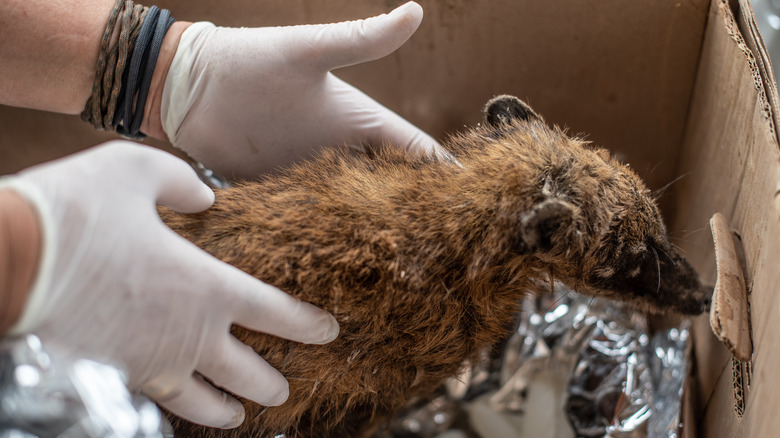The Steps To Take If You Encounter An Injured Wild Animal
Seeing a hurt animal in the wild is heartbreaking, but intervening the wrong way can do more harm than good. Every year, well-meaning attempts to help wildlife lead to unintended consequences. For instance, one young Colorado girl mistook a coyote hiding behind and partially obscured by a tree for a dog and advanced toward it, resulting in an attack. In another case, someone removed a black bear cub from a tree to get a photo with it, causing the bear significant distress before it was rescued and released back into the wild. These incidents highlight the dangers of acting impulsively, as well as the importance of observing and understanding wildlife behavior. For starters, you can read up on the differences between domestic and wild dogs to understand them better.
When you encounter an injured animal, begin with careful observation. Signs of distress may include visible injuries, abnormal behavior, or, in young animals, prolonged absence of a parent. However, not all lone animals need help — many, like fawns or baby birds, are often left alone temporarily, so it's important to consider this sign in tandem with others. Safety is also crucial. Injured animals can be unpredictable, so maintain a safe distance, keep children and pets away, and avoid direct contact. If handling is necessary, wear gloves or use a towel, and wash your hands thoroughly afterward.
Minimize stress for the injured animal and call for help
Once you've assessed the situation and ensured your safety, the next step is to take action responsibly. For example, a family in Texas recently attempted to help a baby bird by folding a warm tortilla around it to protect it. This could have caused unnecessary stress, not to mention potentially cutting off its oxygen supply. The family called a wildlife rehabilitator after handling the bird, though this should've been the first step after noticing it was injured, per Animal Rescue of the Rockies.
In contrast, one woman in Minnesota encountered a snowy owl trapped in a car grille. She carefully removed the owl, caressed it in a blanket, and left it in a hushed room overnight. In the morning, she transported it to a licensed wildlife rehabilitator. Her actions — minimizing stress and seeking professional help — potentially gave the owl its best chance at recovery.
When you come across an injured wild animal, contacting professionals should always be your first step. While waiting for assistance — or transporting the animal — it's important to minimize its stress. Place the animal in a well-ventilated box lined with a soft cloth. Make sure it has enough room to breathe but not enough to move excessively, as this could worsen its injuries. Keep the environment as quiet and dark as possible to reduce fear and agitation, and avoid feeding or giving water to the animal unless directed by a professional. For species-specific advice, check out our guides on how to help a bird with a broken wing or how to help an injured duck.
If you encounter an injured or sick wild animal, contact a local wildlife rehabilitator for help. To find assistance in your area, visit the Humane Society of the United States website or Animal Help Now's online directory.

